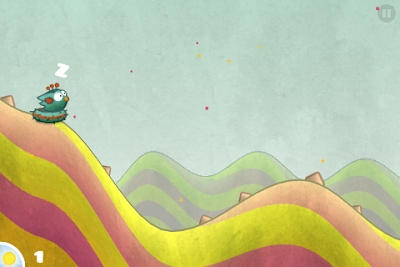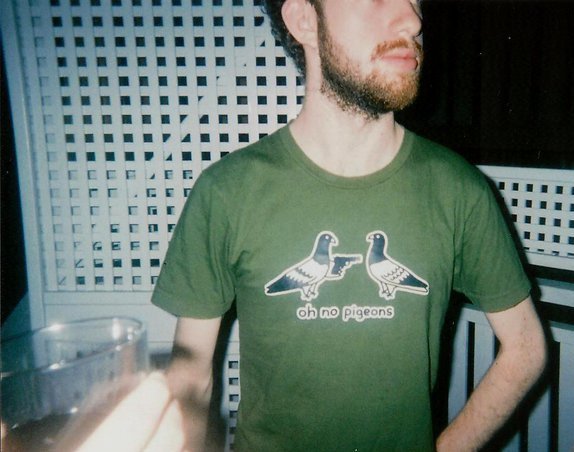Saturday, February 26, 2011
Two Tiny Wings And One Big Heart
Andreas Illiger's adorable Tiny Wings soared onto the iOS app store this week. Quite suddenly, half my Twitter feed was talking about this charming new Canabalt-esque game (‘Canabalt-esque now being pretty much its own genre). Between downloading the game, playing two rounds, and going back to the app store to give the game a five-star rating, over a hundred new reviews appeared. And what good reviews, too! Players say they love it, that is it beautiful. The compliments are vague and abstract (though, looking back several hours later, the number of reviews has quadrupled and there are more specific comments now, both complimentary and critical), but they mirror my own feeling on the game perfectly: Tiny Wings is lovely, and it makes you feel good.
The premise is that you are a bird who will never be able to fly because your wings are too tiny. But this doesn’t stop our little disproportionate hero from trying anyway. He wants to fly, and he will do it however he can. With a touch on the iPhone’s screen, the bird folds his wings back to plummet towards the ground and speed down hills; when you release, he soars off the incline of the next hill like a stunt jump, flapping frantically. The key is to time your drops to get the most speed and height for the next jump. If you do it right, you might even touch the clouds.
It’s a fun and addictive experience, much like that of Canabalt—as simple as it is complex. But also like Canabalt, the true beauty and depth lies not just in the mechanics, but in the game’s fiction. The character, the visuals, the animations, and the music all come together to make Tiny Wings about a disadvantaged bird who got the arse-end of life but refuses to give up on his dreams. Tiny Wings makes you want to grin and cry at the same time. Ultimately, it just feels good.
‘Good’ in the way the ending of Cool Runnings feels good (at the very least, how Cool Runnings felt good after a few vodkas the last time it was on TV). Just like the Jamaican Bobsled Team, the tiny bird tries so hard and overcomes so many challenges, but can never quite reach his goal—at least not for good. It’s both heart-warmingly uplifting and tear-jerkingly sad to watch your bird launch into the clouds—so happy he has touched his dreams; so sad that it will be so fleeting as he falls back to earth. But the moment he lands he is eager to try again and again and again.
The music, an uplifting twang of guitars and blare of trumpets that wouldn’t be out-of-place on a Polyphonic Spree album, complements the themes beautifully. If the bird’s whimsical cry of joy when he launches into the sky doesn’t make you smile, the music will.
Tiny Wings is a fun game. It is mechanically competent and has an excellent, simple-yet-deep scoring system that tempts you to play over and over again, as all games in the Canabalt genre should. But while these elements alone would make Tiny Wings a great game, it is the emotional investment enabled by the game’s aesthetic design coupled with these mechanics that make it truly remarkable. That little bird never stops trying to reach his dreams, even if he can only realise them for a second at a time.
Friday, February 4, 2011
Thieves, Poachers, Pokemon, and Me.
| (Anyone got a reference for this picture?) |
After battling through half a dozen trainers just south of Violet City, I’m relieved to see the Pokecentre at the entrance to Dark Cave. It seems like a fairly odd, out-of-the-way place for a Pokecentre, but I’m not complaining; I’m only a few hours into my adventure on HeartGold, and my pokemon can hardly survive three consecutive battles in a row without fainting. It would be nice to give my pokemon a rest before venturing on.
A slightly overweight man is standing around outside by himself. I have a quick word to him as I pass.
“Pssst! Wanna buy a Slowpoke tail?”
A Slowpoke… tail? As in, the tail of a Slowpoke? As in, you removed a limb from a pokemon, and now you are trying to sell it to me?
Half-confused, half-shocked, I speak to the man again to make sure I heard correctly. Sure enough, I had. Adding to the absurdity of this interaction, when I tell him that I indeed do not want any Slowpoke tail, he tells me to ‘scram’—a jarringly rude remark in a world as polite and cheerful as that of pokemon. I enter the Pokecentre, still unsure as to what just happened.
Pokemon games, more than the average videogame, have always had to fend off baseless accusations from those trying to protect the defenceless minds of gullible, influential children. Pokemon promotes violence; Pokemon promotes gambling; Pokemon is nothing but an empty marketing scheme that exists solely to separate children from their pocket money. Most of these accusations are hyperbolic or rely on an annecdotal case study of a single child. They also completely disregard the many benefits of Pokemon, such as motivating kids to learn how to read from a young age, basic maths and logic, problem solving skills, and the general themes of cooperation and sharing that permeates the series.
In generally, the population of Pokemon’s worlds reflect all the good things we want children to think about the real-world: people are polite, selfless, and generous; animals are cute, friendly and obedient; everybody lives comfortably and within their means; and, uh, Dad is never home. So being told to ‘scram’ by someone who offered to sell me the limb of a pokemon was nothing short of shocking.
Which leads me to the one accusation often levelled at Pokemon games that seems to have a bit more friction: Pokemon promotes animal cruelty. While still exaggerated beyond all fairness, it is hard to ignore that the supposedly symbiotic relationship between mankind and pokemon seems to be defined as “man forcibly removes pokemon from natural habitat; man imprisons pokemon; man forces pokemon to battle other pokemon and to complete tasks solely for man’s benefit.”
It’s a problem at the core of the series’ design and fiction, yet one the series has gotten away with ignoring for nearly two decades by concealing it in layers of positive themes, cute creatures, and content people. Everybody—man and pokemon alike—is happy, so what’s the problem?
Which made my encounter with the shady man outside the Pokecentre so much more jarring. In a world where international terrorism seems to be equivalent to real-world juvenile delinquency, being offered illegally poached goods and then told to scram was not something I was ever expecting to happen.
More than any previous Pokemon titles I have played, then, HeartGold seems willing to accept that the relationship between man and pokemon is not one of perfectly balanced symbiosis. While man and pokemon are indeed able to live happier lives through cooperation, man is also able to live a far easier and profitable life through taking advantage of pokemon.
| (By http://goodcitizen.deviantart.com) |
Previous titles have ignored this imbalance or, at the very least, it has been held back by the typically well-natured people that populate the games. But HeartGold tackles it from the very beginning. In the opening sequence where you choose your first pokemon, the typical trope is that you choose pokemon X, and your friend chooses pokemon Y (where X is weak against Y). HeartGold usurps this with a slightly different formula: “You choose X, your friend has already chosen Z, and someone else steals Y.”
Steals! A young pokemon is stolen and forced to battle by an evil-hearted trainer! Professor Elm tells the player directly his concerns for the wellbeing of that pokemon: if the owner is evil, the pokemon will more likely than not grow up to become evil-hearted themselves. What a horrible fate for a living creature, to be raised in such a way that your fundamental outlook on the world is one of evil and corruption.
That someone could steal a pokemon and force it to act a certain way hints, from very early in the game, that the relationship between man and pokemon is not as simple and balanced as previous games would like to think. Rather, mankind has a significant responsibility to the relationship and is just as capable of taking advantage of the creatures as they are of cooperating with them.
Things quieten down for a time and my initial shock at the idea of a pokemon being stolen fades. But then I encountered the rude, obese Slowpoke tail smuggler. The plot thickens in the next town where it becomes apparent that Team Rocket had been rounding up Slowpokes and chopping off their tails to sell on the black market. The tails grow back over time, but how horrid!
And that is as far as my journey into HeartGold has currently progressed. I have a long way to go, but just from these opening hours, I sense a maturity to the series I have not previously encountered (though, I again acknowledge that I have not played the original Gold and Silver versions and the same themes were probably approached in those games, I imagine). In these encounters with the darker members of humanity there is a a heightened self-awareness that challenges not only the player to think in more complicated terms about their relationship to their pokemon, but challenges the series itself to re-evaluate the mechanics at its very core—not so much in the sense that the mechanics are morally questionable, but that they are just more morally complicated than previously assumed.
While the thief steals a pokemon to use for evil, you, on the other hand, now have the option to keep one of your pokemon outside of their pokeball. It isn’t much, but it is a step in the opposite direction to show how man and pokemon can be true companions, rather than the latter being the tool of the former.
My relationship with my pokemon has always been “I tell my pokemon to do something, and they do it; everyone is happy.” However, The pokemon thief, the smuggler, and the poaching of slowpokes by Team Rocket show that this relationship is too simplistic. I must consciously treat my pokemon well or consciously take advantage of them. There is no unconscious middle ground. It is something previous titles have tried to urge in the cutesy, throwaway dialogue, but I’ve never had the imperative to take it seriously. Why put an effort into treating my pokemon well when the alternative is, well, when there is no alternative? But this time, in a iteration of the Pokemon universe where humans exist that intentionally abuse pokemon, my pokemon and their quality of life are completely, utterly my responsibility.
Subscribe to:
Posts (Atom)








